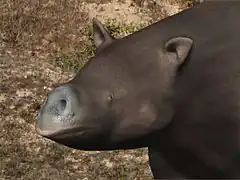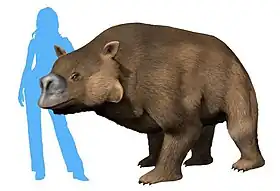Euryzygoma
Euryzygoma dunense
Euryzygoma

Image de synthèse d'Euryzygoma dunense
† Euryzygoma
Longman, 1921
Longman, 1921
Euryzygoma est un genre fossile de grands marsupiaux de la famille des Diprotodontidae, qui vivait au Pliocène dans le Queensland, en Australie.
Historique
Le genre Euryzygoma a été décrit par Albert Heber Longman en 1921[1]. Une seule espèce est rattachée au genre, Euryzygoma dunense, décrite par Charles Walter De Vis en 1888[2].

Vue d'artiste d'Euryzygoma dunense
Description
Euryzygoma pourrait avoir pesé environ 500 kg[3].
Références
- (en) Longman, A new genus of fossil marsupials, Memoirs of the Queensland Museum, vol. 7, p. 65-80, 1921
- (en) De Vis, On a supposed new species of Nototherium, Proceedings of the Linnean Society of New South Wales, vol. 2, n° 2, p. 1065-1070, 1888
- (en) R. D. E. MacPhee, Extinctions in Near Time, Springer Science & Business Media, (ISBN 9780306460920, lire en ligne)
Bibliographie
- (en) Michael Archer, Suzanne J. Hand, Henk Godthelp, « Australia's Lost World: Prehistoric Animals of Riversleigh »
- (en) John A. Long, Michael Archer, Timothy Flannery, Suzanne Hand, « Prehistoric Mammals of Australia and New Guinea: One Hundred Million Years of Evolution »
- (en) Longman, A new genus of fossil marsupials, Memoirs of the Queensland Museum, vol. 7, p. 65-80, 1921
- (en) De Vis, On a supposed new species of Nototherium, Proceedings of the Linnean Society of New South Wales, vol. 2, n° 2, p. 1065-1070, 1888
Liens externes
- Ressources relatives au vivant :
Cet article est issu de wikipedia. Text licence: CC BY-SA 4.0, Des conditions supplémentaires peuvent s’appliquer aux fichiers multimédias.